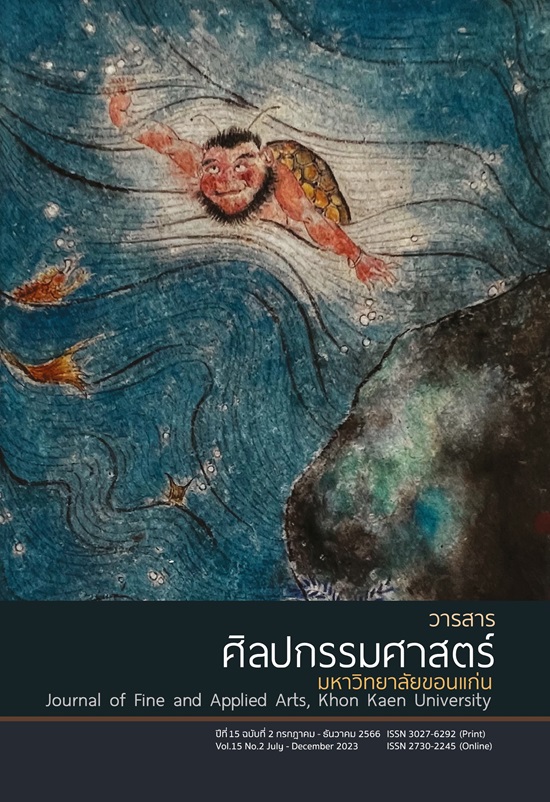The การพัฒนาวัสดุเหลือใช้จากหัตถกรรมเตยปาหนันเป็นวัสดุใหม่เชิงสร้างสรรค์ กรณีศึกษา วิสาหกิจชุมชนผลิตภัณฑ์เตยปาหนันบ้านดุหุน จังหวัดตรัง
Main Article Content
บทคัดย่อ
การวิจัยครั้งนี้เป็นการวิจัยแบบ Practice-based Research มีวัตถุประสงค์เพื่อ 1) ศึกษาแนวทาง และความเป็นไปได้ในการพัฒนาเศษวัสดุเหลือใช้จากหัตถกรรมเตยปาหนัน 2) การทดลองการพัฒนาเศษวัสดุเหลือใช้จากหัตถกรรมปาหนันเป็นวัสดุใหม่เชิงสร้างสรรค์ พื้นที่ศึกษาคือ วิสาหกิจชุมชนผลิตภัณฑ์เตยปาหนันบ้านดุหุน จังหวัดตรัง มีการเก็บข้อมูลด้วยการบันทึกข้อมูลการทดลองและผลการทดลองอย่างเป็นขั้นตอน วิเคราะห์ข้อมูลจากผลสรุปการทดลองในขั้นตอนต่างๆ ผลการศึกษาพบว่า การย่อยเส้นใยจากเศษวัสดุเส้นตอกเตยปาหนันโดยการแช่ด้วยน้ำหรือน้ำเกลือและใช้ความร้อนด้วยการต้มทำให้สีของเส้นตอกเตยอ่อนลงเล็กน้อยแต่ไม่สามารถย่อยเส้นใยได้ เมื่อมีการทดลองแช่ด้วยสารโซเดียมไฮดรอกไซด์ และการแช่ด้วยด้วยสารฟอกขาวแล้วนำไปต้มทำให้สีของเส้นตอกอ่อนลง ระยะเวลาที่นานขึ้นในการแช่ และการต้มก็มีผลซึ่งเส้นใยจะเริ่มย่อยมากขึ้นเรื่อยๆ มีการนำเศษวัสดุที่ได้จากการย่อยเส้นใยไปสร้างสรรค์วัสดุใหม่เป็นรูปทรง 2 แบบ คือ 1. รูปแบบลักษณะแผ่น : การใช้เยื่อเตยที่ต่ำกว่า 100 กรัม ในเฟรมขนาด A4 ทำให้วัสดุขาดบางจุด แต่การใช้เยื่อที่มากกว่า 100 กรัม แผ่นวัสดุจะมีความหนาขึ้น การเติมส่วนผสมสารให้ความเหนียว (CMC) กับเนื้อเยื่อทำให้วัสดุมีความเหนียวและแข็งแรงขึ้น 2. รูปแบบลักษณะสามมิติ : สามารถขึ้นรูปทรงด้วยมือ และการใช้แม่พิมพ์ วัสดุที่ได้มีน้ำหนักเบา ผิวขรุขระ ความเป็นไปได้ในการพัฒนาต่อเนื่องสามารถพัฒนาวัสดุใหม่เชิงสร้างสรรค์ในรูปแบบกระดาษปาหนันให้มีลักษณะพื้นผิวแบบต่าง ๆ อันเกิดจากวิธีการย่อยเส้นใย รวมทั้งการสร้างความตระหนักตามแนวคิด circular economy ซึ่งให้ความสำคัญกับการใช้ทรัพยากรอย่างคุ้มค่าเพื่อให้ชุมชนนำแนวทางไปใช้พัฒนาต่อไป
Article Details

อนุญาตภายใต้เงื่อนไข Creative Commons Attribution-NonCommercial-NoDerivatives 4.0 International License.
เนื้อหาและข้อมูลในบทความที่ลงตีพิมพ์ในวารสารคณะศิลปกรรมศาสตร์ มหาวิทยาลัยขอนแก่น ถือเป็นความคิดเห็นและความรับผิดชอบของผู้เขียนบทความโดยตรง ซึ่งกองบรรณาธิการไม่จำเป็นต้องเห็นด้วย หรือร่วมรับผิดชอบใด ๆ
บทความ ข้อมูล เนื้อหา รูปภาพ ฯลฯ ที่ได้รับการตีพิมพ์ในวารสารคณะศิลปกรรมศาสตร์ มหาวิทยาลัยขอนแก่น ถือเป็นลิขสิทธิ์ของวารสารคณะศิลปกรรมศาสตร์ มหาวิทยาลัยขอนแก่น หากบุคคลหรือหน่วยงานใดต้องการนำทั้งหมดหรือส่วนหนึ่งส่วนใดไปเผยแพร่ต่อหรือเพื่อกระทำการใด ๆ จะต้องได้รับอนุญาตเป็นลายลักอักษรจากวารสารคณะศิลปกรรมศาสตร์ มหาวิทยาลัยขอนแก่น ก่อนเท่านั้น
เอกสารอ้างอิง
กรมป่าไม้. (2563). เตยปาหนัน การศึกษาภูมิปัญญาท้องถิ่น. กรุงเทพฯ : เอ็น.พี.จี. เอ็นเตอร์ไพรส์.
กรมส่งเสริมการเกษตร. (2560). วิสาหกิจชุมชนผลิตภัณฑ์เตยปาหนันบ้านดุหุน. ค้นเมื่อ 18 มกราคม 2565 จากhttps://smce.doae.go.th/ProductCategory/managecontent.php?smce_id=59205011000
กรมส่งเสริมการค้าระหว่างประเทศ. (2563). DEWA: Design from Waste of Agriculture เอกสารเผยแพร่สรุปผลโครงการกิจกรรมการพัฒนาผลผลิตเหลือใช้ทางการเกษตรเพื่อแปรรูปเป็นผลิตภัณฑ์เชิงสร้างสรรค์สู่ตลาดสากล (DEWA 2020). กรุงเทพฯ : กรมส่งเสริมการค้าระหว่างประเทศ.
ไกรลาส จิตร์กุ, และอาทิตยา ผิวขำ. (2560). การสร้างสรรค์งานศิลปะการแสดงที่มีฐานการหาข้อมูลจากวิธีวิจัย. ใน ศาสตร์พระราชาเพื่อการพัฒนาที่ยั่งยืน: รวมบทความวิจัย บทความวิชาการ มหาวิทยาลัยราชภัฏเชียงใหม่ ประจำปี พ.ศ. 2560. (หน้า 145-154). เชียงใหม่ : มหาวิทยาลัยราชภัฏเชียงใหม่.
จุฑามาส เรืองยศจันทนา, และรัชฎา บุญเต็ม. (2560). การสกัดเซลลูโลสและการทำกระดาษจากเปลือกข่อย. วารสาร Veridian E Journal มหาวิทยาลัยศิลปากร สาขาวิทยาศาสตร์และเทคโนโลยี, 4 (3), 50-59.
ประชาคมวิจัยด้านเศรษฐกิจชีวภาพ เศรษฐกิจหมุนเวียน และเศรษฐกิจสีเขียว. (2561). สมุดปกขาว BCG in Action การพัฒนาวิทยาศาสตร์ เทคโนโลยีและนวัตกรรมของประเทศไทยเพื่อเศรษฐกิจชีวิตภาพ เศรษฐกิจหมุนเวียน และเศรษฐกิจสีเขียว Bio–Circular–Green Economy. ค้นเมื่อ 5 มกราคม 2565, จาก http://stiic.sti.or.th/work/bcg-model/
พอลล่า เตฆอน คาร์บาฆาล. (2563). เศรษฐกิจหมุนเวียน (Circular Economy) ดีต่อสิ่งแวดล้อมจริงๆ หรือไม่? ค้นเมื่อ 18 มกราคม 2565, จาก https://www.greenpeace.org/thailand/story/ 17209/plastic-slowing-the-circular-economy/
ศูนย์คลังสมองกลุ่มวิสาหกิจชุมชนบ้านพรุจูด. (2563). กลุ่มจักสานเตยปาหนันบ้านดุหุน. ค้นเมื่อ 5 มกราคม 2565, จาก http://smce-prujud.com/วิสาหกิจชุมชน/กลุ่มจักสานเตยปาหนัน-บ้านดุหุน.html
สถาบันส่งเสริมศิลปหัตถกรรมไทย (องค์การมหาชน). (2561). เตยปาหนัน. ค้นเมื่อ 20 มกราคม 2564, จาก https://www.sacit.or.th/th/detail/2018-08-16-14-43-07
สากล ฐินะกุล. (2560). แนวทางการส่งเสริมผลิตภัณฑ์จากวัสดุเหลือใช้ที่เป็นมิตรกับสิ่งแวดล้อม 2560. สืบค้นเมื่อ 6 กรกฎาคม 2565, จาก https://datacenter.deqp.go.th/media/37400/ gupcyclepromotionguildline-by-general-dupof-deqp.pdf
สำนักงานบริหารและพัฒนาองค์ความรู้ (องค์การมหาชน). (2564). Upcycle เทรนด์ใหม่ของคนสายกรีน. ค้นเมื่อ 5 มกราคม 2565, จาก https://www.okmd.or.th/okmd-kratooktomkit/4396/
สำนักงานพัฒนาวิทยาศาสตร์และเทคโนโลยีแห่งชาติ. (2562). เศรษฐกิจหมุนเวียน circular economy. ค้นเมื่อ 2 เมษายน 2565, จาก https://www.nstda.or.th/home/knowledge_post/circular-economy-article/
สำนักงานส่งเสริมเศรษฐกิจสร้างสรรค์. (2563). อัตลักษณ์วัสดุถิ่นใต้. กรุงเทพฯ : สำนักพัฒนาองค์วามรู้เศรษฐกิจสร้างสรรค์.
สำนักงานสภานโยบายการอุดมศึกษา วิทยาศาสตร์ วิจัยและนวัตกรรมแห่งชาติ. (2565). BCG in action: The new sustainable growth engine. ค้นเมื่อ 20 มกราคม 2565, จาก https://www.nxpo.or.th/th/bcg-economy/
สำนักงานสภาพัฒนาการเศรษฐกิจและสังคมแห่งชาติ. (2565). ยุทธศาสตร์ชาติด้านการสร้างการเติบโตบนคุณภาพชีวิตที่เป็นมิตรต่อสิ่งแวดล้อม. ค้นเมื่อ 18 มกราคม 2565, จาก http://nscr.nesdc.go.th/ยุทธศาสตร์ชาติ/ด้านการสร้างการเติบโต/
องค์การบริหารจัดการก๊าซเรือนกระจก (องค์การมหาชน). (2564). เศรษฐกิจหมุนเวียนคืออะไร. ค้นเมื่อ 5 เมษายน 2565, จาก http://carbonmarket.tgo.or.th/index.php?lang=TH&mod=Y2VfaXM=
Candy, L. (2006). Practice based research: A guide. Retrieved April 20, 2022, from https://www.creativityandcognition.com/wp-content/uploads/2011/04/PBR-Guide-1.1-2006.pdf
Designboom. (2022). Recycling. Retrieved April 20, 2022, from https://www.designboom.com/ tag/recycling/
Rahman. A. W., Sudin S. N. A., & Din, S. N. (2012). Physical and mechanical properties of Pandanus amaryllifolius fiber reinforced low density polyethylene composite for packaging application. In 2012 IEEE Symposium on Humanities, Science and Engineering Research, Kuala Lumpur, Malaysia, 2012. (pp. 345-349). Malaysia : IEEE.


